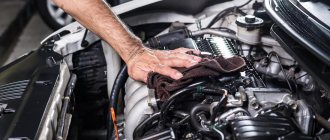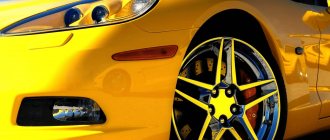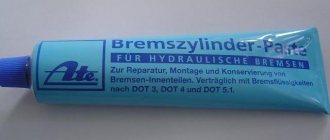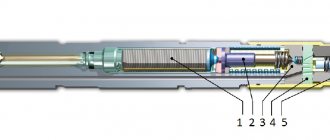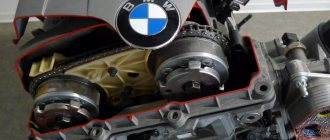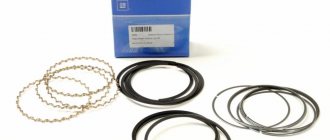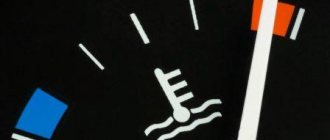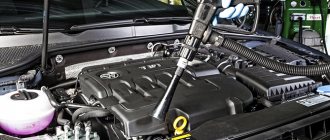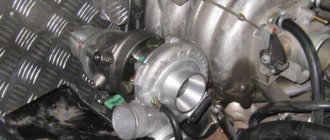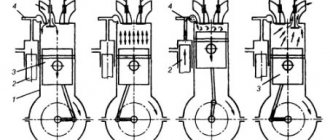Any car deteriorates and wears out over time, and this applies not only to the body or interior elements. Much more trouble for car owners is caused by malfunctions of the engine and other vehicle systems that arise as a result of long-term use of the vehicle.
Sooner or later, every driver is faced with the need to overhaul the power unit, which involves replacing most of the components of the cylinder-piston group and the crank mechanism. The result is an engine that has been updated almost to its original condition, which at first must be run in in the same way as a completely new car.
Of course, there are some differences, and we will definitely talk about them in our review.
Why is the engine broken in?
Engine repair, even if carried out using expensive equipment, cannot be compared with factory production, therefore, the treated surfaces almost always have microscopic irregularities and deviations from the ideal geometry. Therefore, grinding in the power unit is necessary to ensure that such extremely minor defects (typical, by the way, for new engines) do not develop into significant ones. And the risk of more serious troubles increases many times over if the car is not operated in a gentle manner at first.
Until the rubbing parts have worked in, the motor should not be allowed to overheat - this can lead to further deformation of the motor elements. Running in the engine after the overhaul assumes that the car owner will drive at the recommended speed limit for approximately 3 thousand kilometers after the overhaul. However, complete grinding of the rubbing surfaces, in which all irregularities are smoothed out, occurs, as practice shows, after driving 10,000-15,000 kilometers. Over the specified period of time, the likelihood of significant scoring, as well as melting of rubbing parts, is significantly reduced.
Approximate recommendations for drivers are to drive during break-in at 60% of normal loads. Please note that this is an indicative figure, since the driving style of different drivers may vary significantly.
Regardless of whether the engine parts were processed using a homemade method, or new factory-made components were installed, running-in is indispensable, and here’s why:
- You assemble the engine yourself or at a service station. There is no need to talk about maintaining precise tolerances for obvious reasons;
- since you are not replacing the entire engine, there are always old components and parts that, due to natural wear and tear, will no longer correspond to the new ones;
- Since new parts are produced using cutting tools, even after finishing there are always at least areas that do not fully match the original geometry.
First start of the power unit
Assembling the motor is an extremely important stage. Any mistake can have very serious negative consequences. The first start of the engine after repair work is no less important. We can say that following the correct sequence of actions largely determines how successful the subsequent running-in of the engine will be.
Here is the algorithm for the first engine start after a major overhaul:
- make sure that the battery is fully charged - due to the presence of micro-irregularities, all its power may be needed to turn the crankshaft;
- Great importance should be given to engine oil: it must not only correspond to that recommended for a given engine, but also be of high quality. Filling the MM should be carried out to the upper limit mark of the dipstick - after 15 minutes, some of the oil will drain into the pan, and it may need to be topped up, but this time not reaching the MAX mark. It is not recommended to pour lubricating fluid into the oil filter - inept performance of this operation can lead to the formation of an air plug in the oil line;
- for diesel and carburetor power units, fuel must be supplied to the system manually;
- If all preparatory manipulations have been completed, you can start starting the engine. In this case, be sure to check the oil pressure lamp. Compared to a normal start, it should burn a few seconds longer, but if after 5-7 seconds it does not go out, you should immediately turn off the engine and begin to find out the reason why the oil pressure was not brought back to normal;
- When starting the engine with the starter, do not help it with the accelerator - the increased load here is not only inappropriate, but unacceptable. But the depressed clutch will come in handy;
- If the light goes out, you should warm up the engine to 85-92°C at idle speed, without gases. While the engine is warming up, you can look into the engine compartment and under the car to make sure there are no leaks of technical fluids, including oil and antifreeze. Remember that the appearance of a burning smell during the first start-up after capitalization is normal; this is the result of burnout of lubricants applied during engine assembly. After the power unit reaches operating temperatures, there will be a slight drop in the MM pressure in the system, as the hot liquid becomes more liquid. Acceptable pressure is considered to be in the range of 0.4-0.85 kg/cm2. If it is less, it means that there are problems that arose either as a result of assembly errors or due to the use of low-quality lubricating fluid;
- After warming up, the engine must be turned off and started back only after it has cooled to 40 degrees. About one and a half dozen such engine start/stop cycles should be carried out, after which you can let the engine run at higher speeds (for the first three minutes - at a thousand rpm, then for four to five minutes - at one and a half thousand rpm, after which Let the engine run at 2 thousand rpm for 5 minutes).
First engine start after overhaul
After assembling the car engine, you need to put it back in and, most importantly, perform the first start correctly.
Upon completion of the overhaul, the engine is not yet ready for normal operation. The first start of the engine is carried out only after the so-called cold running-in, when the rotation of the crankshaft is ensured by an external force (on a stand or by towing). In addition, even if no errors were made during engine assembly after a major overhaul, a number of problems are possible at start-up.
The engine does not start after overhauling - causes and solutions
If this problem occurs, the fuel system may not be full or there is not enough pressure in the rail. It is necessary to force the pump to run and check the pressure with a pressure gauge. The fuel pressure valve may also be faulty or incorrectly connected.
This often happens because there is no spark on the spark plugs (gasoline engine), the spark plugs are filled with fuel. In this case, you need to check the gaps and blow out the cylinders.
Sometimes the engine cannot be started because the crankshaft position sensor is not working. In this case, you should check the connection and measure the pulses.
After overhaul the engine smokes
At first, this is how it should be. This is caused by the fact that traces of washing liquids and lubricants remain in the internal cavities. Another possible reason is loose seals. It is possible that oil got into the exhaust pipe during assembly.
If smoke continues to come from the exhaust system after hot running, check the cylinder cavities. The oil scraper rings may be incorrectly positioned or the cylinder head gasket may not be installed tightly.
Engine gets hot after overhaul
This may be due to incorrect operation of the cooling system. First of all, after a major overhaul, it is necessary to remove air from the radiator pipes.
Check the pump's functionality. When you open the expansion tank cap, you should see antifreeze moving out of the supply hole. When the liquid warms up, the thermostat is activated. The supply pipe to the radiator should become warm.
After engine overhaul, fuel consumption increased
This is normal. It is necessary to undergo initial training on the on-board computer. The technique is described in the vehicle's operating instructions. Training cycles:
- Idle operation without turning on additional equipment;
- supplying a moderate load: turning on external lighting, multimedia system, air conditioning.
- switching the automatic transmission selector to “drive” mode while pressing the brake pedal;
- starting off at idle (you need to drive a short distance)
- driving in normal mode without a sharp increase in speed.
Duration and features of engine running-in after capitalization
The most important period for a rebuilt engine is the first three thousand kilometers. During this period, it is extremely important to strictly follow the recommended driving regime, especially until the vehicle reaches a thousand kilometers. We list the general rules for running in:
- Driving at high speeds is unacceptable; driving at low speeds relative to the nominal speed is also undesirable;
- a gentle driving mode does not mean that you should move at a constant speed and speed - the driving rhythm needs to be changed, but within acceptable limits;
- Loading the car for the break-in period, much less using a trailer, is extremely undesirable;
- You should avoid sudden acceleration/braking and completely abandon the habit of engine braking.
Strictly speaking, running-in does not allow even short-term operation of the engine in heavy conditions. You should always start with very moderate loads, gradually increasing them. Long-term operation at idle is undesirable (only to warm up the power unit), since idling for a car is also considered a difficult and difficult mode.
As with a new car, the engine oil should be changed after driving the first thousand kilometers. In this case, engine flushing is unacceptable, as is the use of all kinds of additives and additives.
Let's consider the features of running in the power unit, depending on the scope of work carried out as part of a major overhaul. Recovery can be complete or partial. A complete reconstruction of the engine assumes that work has been carried out affecting all the main engine systems: CPG, crankshaft, timing belt. In this case, the recommended run-in mileage is at least 3,000 kilometers. Partial repairs involve the replacement and restoration of individual engine components (piston rings, camshaft, valves), and in most cases, to grind in the parts, it is enough to drive a thousand kilometers in a gentle mode.
Since a complete “capital” is more common, we provide recommendations for running-in specifically for this case:
- before setting off on the road, you should warm up the power unit at idle, but not for too long (we have already said that this is harmful) - it will warm up to operating temperature while driving;
- It is advisable to plan your route in such a way as to minimize travel on steep slopes. During the run-in period, passengers are not welcome in the cabin;
- engine braking, quick acceleration and emergency braking are unacceptable;
- The recommended driving speed is 60 km/h, regardless of the type and power of the engine. In this case, the speed should be kept below 2500 rpm and dropped for a long time below 1500 rpm. Beware of the operation of the power unit in tension;
- A common mistake is the desire to drive in one gear, maintaining a constant speed. The dosage of load on the motor should be smooth, deceleration/acceleration should be present, but the speed should always correspond to the selected gear. In this case, the engine operates at average speed for this mode.
Moderate driving in all senses during break-in provides the piston rings with the opportunity to settle, settle more comfortably in their places - the piston grooves, the surface of the cylinders gradually acquires a mirror cleanliness, etc. That is, real driving allows you to smooth out all those inaccuracies that cannot be eliminated during grinding, even with the most modern equipment.
We also note that the specified break-in period of 3,000 kilometers is considered the minimum required for a complete overhaul, while complete grinding in of the moving elements of modern internal combustion engines occurs after driving 7,000-10,000 kilometers. In other words, the light running-in mode should last much longer. Maximum loads are permissible only after the above segment.
Rules for changing oil after adjusting valve clearances and replacing piston rings
Such repair operations do not introduce as many small metal particles as a complete overhaul of the engine. Therefore, it is best to adjust the valves 1-2 thousand km before the scheduled oil and filter change.
When replacing piston rings, it is recommended to change the oil and filter after 1.5-2 thousand kilometers from the date of repair.
Methods for running in the engine
The algorithm described above is a classic natural run-in. But besides this, there are at least three more ways to grind in parts of a restored power unit:
- cold rolling method, performed using a special stand;
- cold running, performed without a stand;
- method of hot lapping of engine parts.
Let's consider the features of each of the listed methods.
Run-in on the stand
Of course, the stand itself is very expensive equipment. Only large service stations can afford it, but thanks to its use it is possible to gain complete control over all technological stages of running-in.
In this case, the power unit is installed on a stand and started by connecting to the driveshaft, which, in turn, is driven by an electric motor, which is considered to be leading in relation to the car engine.
A special device called an encoder controls the rotation speed of the drive engine, while the tachometer records slightly less accurate readings. The bench equipment operates under the control of a microprogram that regulates the operating parameters of the electric motor, based on sensor readings.
The total duration of operation of the driving/driven motor pair is determined by the scope of work performed as part of the vehicle's overhaul. In particular, normal grinding in of a new cylinder-piston group requires approximately three hours of continuous rotation of both engines.
The result of such cold grinding suggests that the following indicators were achieved:
- when the SA operates at idle (at speeds not exceeding 600 per minute), the speed stabilizes;
- pressing the accelerator pedal in the same mode does not lead to interruptions in the operation of the lead engine, and it should not stall.
Let us note that purchasing an expensive stand for cold running-in is not enough - you also need a specialist who is well versed in the nuances of reaching a certain mode, and in unquestioning adherence to the technology of grinding in parts.
Benchless cold running
It consists of towing the car in third gear, but with the engine turned off, for 2-3 hours. Before running-in, the car is filled with all necessary technical fluids, including oil and antifreeze/antifreeze.
Although experts do not recommend using this method, it has become widespread among garage repairmen.
Hot running
It is carried out directly on the car, but immobilized. It is characterized by the ability to control the assembly quality of the power unit after overhaul and leveling of minor defects made during the production of parts and assemblies installed instead of worn ones. What’s good is that this technology can also be used in garage conditions. Cold running algorithm:
- start the engine, set the speed to idle speed;
- let it run for about 3-4 minutes, turn off the engine for approximately the same amount of time. We repeat the cycle 10-15 times. Stopping the engine is necessary in order to prevent local overheating of the power unit;
- we start the engine again, set the speed at 1200 rpm, gradually increase it to about 50% of the maximum level. We calculate the increase in speed so that the total operating time of the power unit is 45-50 minutes.
During the last stage, we especially carefully monitor the engine temperature; if it rises uncontrollably, you should turn off the engine, let it cool and only then start it again. If everything is normal, we check the levels of technical fluids and the presence/absence of leaks, and measure the compression of the cylinders. Finally, after the break-in is complete, we set the ignition again and adjust the valve clearances.
Natural engine running-in
We have already given the sequence of classical running-in. It is worth noting that, regardless of the complexity and scope of the restoration work, the running-in should be carried out exclusively in a gentle mode, even if you are limited to only replacing the chain (of course, the total mileage in this case will be minimal, about 500 kilometers).
Driving in fifth gear should be avoided and you should move off very smoothly. We have already talked about the importance of filling in high-quality engine oil, but using good fuel is no less important - at least until the break-in period is completed.
Overhaul process
Disassembly is a troublesome job that requires special skills and the availability of special keys and pullers. To carry out the work, you can use the services of service centers or do everything yourself.
Engine restoration stages:
- Dismantling the power unit. Removal begins with unscrewing the fasteners on the frame and disconnecting the wiring and pipelines from all internal combustion engine components.
- Inspect the component for damage or wear. The obtained data is verified with technical documentation. Based on the measurement results, the need for repairs is determined.
The degree of wear of the cylinder-piston group is determined by the amount of compression. Measurements are taken through the nozzle hole, cranking the engine with the starter.
Parameters under which repairs are necessary
| Limit data for the state of the CPG kgf/cm2 | |
| total vacuum value in the cylinder | value of residual vacuum in the cylinder |
| 0, 78 | 0, 25 |
| Piston ring wear parameters kgf/cm2 | |
| 0, 78 | 0, 25 |
| Cylinder liner wear indicators kgf/cm2 | |
| 0, 66–0, 78 | |
| Parameters that indicate valve wear, loose seating, mechanical damage to the valve base or piston | |
| 0, 65 | |
- Defective component:
- crankshaft: grinding the main and connecting rod journals, checking the journals for hardness, measuring runout, alignment, installing liners in accordance with the repair size;
- cylinder block: boring to repair size, abrasive treatment of the cylinder surface, restoration of the mating plane and crankshaft installation location;
- oil pan: visual inspection for mechanical damage;
- cylinder head: removing carbon deposits from the combustion chamber, replacing guide bushings, grinding valves and seats, troubleshooting the camshaft, adjusting valve operation;
- fuel system: setting the timing and injection pressure on the fuel pump, checking the quality of the injector spray, inspecting the fuel line seats for wear or damage.
Overhaul of diesel engines ends with running-in.
What not to do
We have partially mentioned what it is extremely undesirable to do; for better remembering, we present a list of prohibited actions in full:
- you cannot increase the speed above 2000 rpm;
- Sharp acceleration/braking, especially by the engine, is unacceptable;
- the run-in should be carried out in a lightweight version, without passengers and cargo;
- It is forbidden to engage direct gear, or to drive in a lower gear for a long time. The speed limit should be varied, which will have a positive effect on fuel consumption and the smooth running of the car;
- You should not run-in on busy highways, both in the city and outside it - in this case you will not be able to comply with the recommended regime. The ideal place is a deserted highway, the ideal time is evening or early morning.
During the first start-up, it is advisable to listen to the operation of the power unit in order to identify extraneous sounds that may indicate problems in the operation of the restored engine.
